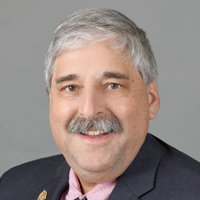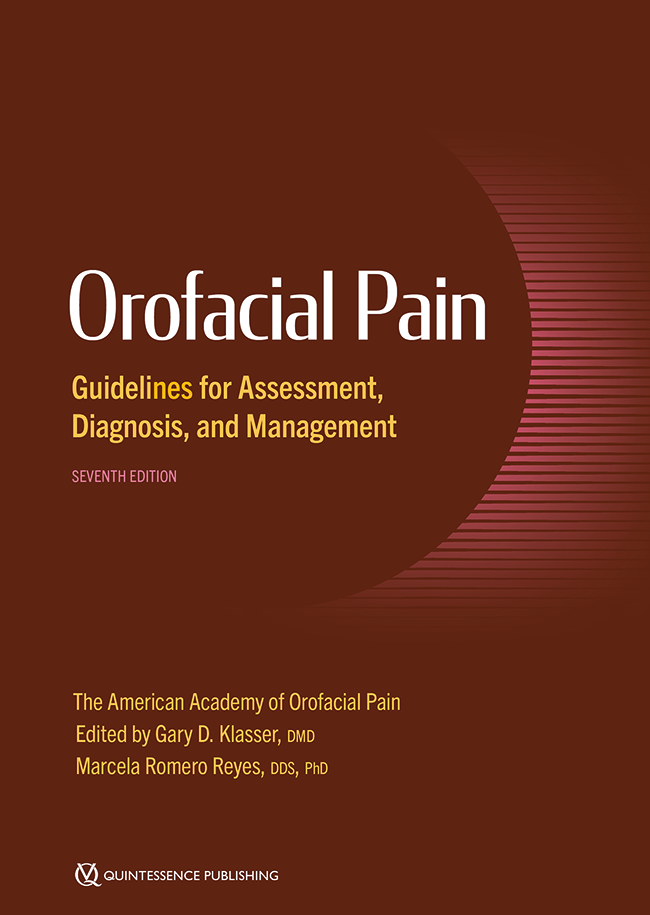Quintessence International, 5/2024
DOI: 10.3290/j.qi.b5410535, PubMed-ID: 38813810Seiten: 346-347, Sprache: EnglischKlasser, Gary D.EditorialQuintessence International, 1/2024
DOI: 10.3290/j.qi.b4418471, PubMed-ID: 37725000Seiten: 60-67, Sprache: EnglischChirravur, Prazwala / Vacharotayangul, Piamkamon / Sroussi, Herve / Klasser, Gary D.Oral dysesthesia (OD) is a diagnosis of exclusion that manifests as an unpleasant and abnormal sensation of the oral mucosa without any noticeable oral lesions. Burning sensation is one of the manifestations of OD which may advocate for similar pharmacotherapeutic options to burning mouth syndrome (BMS), resulting in possible adverse events. The aim of these case reports was to illustrate the significance and rationale for the use of oral devices as a mechanical/physical barrier and a safe approach in the management of OD, without experiencing any antagonistic effects from pharmacotherapeutic agents. Two patients with spontaneous and evoked (following dental procedures) OD symptoms in the right posterior mandibular quadrant and anterior hard palatal areas were evaluated. Additionally, their OD symptoms were associated with hyposalivation and taste changes. A thorough history and complete head and neck examination, with the exclusion of oral lesions and systemic conditions, were performed. These patients were previously prescribed topical clonazepam rinses. An in-office trial, with application of orthodontic wax to the affected area, was performed as a preliminary test in order to justify the fabrication of an oral device for possible symptomatic relief.
Conclusion: The case reports demonstrated significant improvement of OD symptoms and amelioration of pain following fabrication of oral devices in two patients with no undesirable effects from pharmacotherapy. Additionally, the oral devices aided as a mechanical/physical barrier, potentially exerting a placebo effect while facilitating an improved quality of life. Furthermore, the cost-effectiveness and ease of fabricating the oral device has been advantageous over other systemic medications. This encourages the need for a detailed prospective study.
Schlagwörter: burning mouth syndrome, central and peripheral sensitization, mechanical/physical barrier, oral devices, oral dysesthesia, somatization
Quintessence International, 4/2023
DOI: 10.3290/j.qi.b3999673, PubMed-ID: 37039380Seiten: 328-334, Sprache: EnglischKlasser, Gary D. / Abt, Elliot / Weyant, Robert J. / Greene, Charles S.Temporomandibular disorders (TMDs) encompass a number of different musculoskeletal disorders often accompanied by pain and dysfunction. Most TMDs are acute, but can become chronic leading to disability and quality of life issues. There is wide variation in treatment of TMDs, including both conservative/reversible therapies as well as invasive/irreversible treatments, which present difficulties for clinicians, patients, and third-party payers as to what constitutes appropriate care. Data sources: A recent report by the National Academies of Sciences, Engineering, and Medicine highlighted a number of deficiencies, most notably in the education of TMDs within United States of America dental schools at both the predoctoral and postdoctoral (dental) levels as well as addressing the historic inconsistencies in both diagnosis and treatment. New areas for research and interprofessional collaboration should assist in the understanding of TMDs, and updated clinical practice guidelines should help reduce variation in the delivery of evidence-based care. Recently, the American Dental Association recognized orofacial pain as a specialty, which should increase the level and availability of expertise in treating these issues. Summary: Based on the current best evidence, this report is an attempt to alert the profession to discontinue irreversible and invasive therapies for the vast majority of TMDs and recognize that the majority of these disorders are amenable to conservative, reversible interventions.
Schlagwörter: American Dental Association, Commission on Dental Accreditation, dental education and research, National Academies of Sciences, Engineering, and Medicine, temporomandibular disorders
Quintessence International, 3/2022
DOI: 10.3290/j.qi.b2407809, PubMed-ID: 34881839Seiten: 270-276, Sprache: EnglischZamora, Jorge Gabriel / Rivera, Carolina / Utsman, Robert / Klasser, Gary D.Chorea-acanthocytosis is a rare neurological disorder that produces involuntary body movements, along with a condition of misshapen red blood cells that is characterized by appearing in early adulthood. There are numerous orofacial manifestations linked to chorea-acanthocytosis that the dental practitioner must consider in early and late stages of the disease, such as chronic oral ulcerations, chronic mouth grinding, difficulty swallowing, and biting the lip and tongue, among others. This case, the first to the authors’ knowledge to address the area of orofacial pain, provides general signs and symptoms of the disorder and management following a multidisciplinary approach. The life span of patients with this disorder is generally shortened, and correct management is essential to improve the quality of life.
Schlagwörter: chorea, dyskinesia, multidisciplinary approach, oral appliance, ulcerations
Quintessence International, 9/2020
DOI: 10.3290/j.qi.a45174, PubMed-ID: 32901233Seiten: 693-694, Sprache: EnglischKlasser, Gary D.Quintessence International, 6/2020
DOI: 10.3290/j.qi.a44566, PubMed-ID: 32424375Seiten: 437-438, Sprache: EnglischKlasser, Gary D.Quintessence International, 2/2014
DOI: 10.3290/j.qi.a30999, PubMed-ID: 24389570Seiten: 157-167, Sprache: EnglischKlasser, Gary D. / Bassiur, Jennifer / Leeuw, Reny deObjective: The aim of this study was to compare self-reported medical conditions between a group of myogenous and arthrogenous temporomandibular disorder (TMD) patients and highlight its relevance to the general practitioner.
Method and Materials: The patient population consisted of 274 consecutive patients (14.6% male, 85.4% female; mean age 39.6 ± 14.2 years) diagnosed with either myogenous or arthrogenous TMD according to the Research Diagnostic Criteria for Temporomandibular Disorders. Self-reported medical conditions were derived from a standardized medical health questionnaire that patients completed during their initial examination. Data were compared between the two groups by means of chi-square tests, t tests and Mann-Whitney U tests. The level of significance was set at α = .05.
Results: Patients with myogenous TMD reported a greater number of medical conditions compared to arthrogenous TMD patients from the following broad categories: neurologic, gastrointestinal, musculoskeletal, psychologic, and "other". The following nine specific conditions were reported significantly more often in the myogenous group: severe headaches, fainting/dizzy spells, gastric acid reflux, fibromyalgia, anxiety, depression, psychiatric treatment, phobias, and frequent sore throats. The myogenous group reported pain to be significantly more severe than the arthrogenous group. Pain duration did not differ between the two groups.
Conclusion: Patients with myogenous TMD self-reported significantly more comorbid disorders and more severe pain than patients with arthrogenous TMD. Understanding the differences between these two groups of patients will allow for more appropriate and targeted care for these populations. Future studies may focus on determining subgroups that are more likely to be indicative of a larger widespread pain syndrome to help guide individualized management strategies.
Schlagwörter: arthrogenous, myogenous, temporomandibular disorders
Quintessence International, 3/2011
PubMed-ID: 21465014Seiten: 259-269, Sprache: EnglischKlasser, Gary D. / Kugelmann, Annette M. / Villines, Dana / Johnson, Bradford R.Objective: To investigate the prevalence of persistent pain of neuropathic origin after nonsurgical root canal treatment and to determine its characteristics, location, and severity utilizing a self-reported validated postal survey.
Method and Materials: A modified version of the Self-Administered Leeds Assessment of Neuropathic Symptoms and Signs (S-LANSS) survey was mailed to 2,338 adult subjects who received a single-tooth nonsurgical root canal treatment at the University of Illinois at Chicago College of Dentistry Postgraduate Endodontics Clinic over a 4-year period. Two-hundred and fifty (10.7%) completed surveys were returned. Descriptive analysis, Pearson correlation to determine correlations between the S-LANSS scores and variables of interest, and t tests for group comparisons of the S-LANSS score were performed. Statistical significance was determined at P .05.
Results: The prevalence of persistent pain of neuropathic origin among respondents after receiving single-tooth nonsurgical root canal treatment was 7% with the average pain reported as 7.2 on a visual analogue scale (where 0 is no pain and 10 is pain as severe as it could be). Neuropathic pain was more common in middle-aged (mean 50.6 years of age) individuals with no sex predilection and occurred more frequently in the mandibular arch without any differences attributable to the number of canals treated. Also, the majority of subjects most frequently endorsed their pain experiences as abnormal sensitivity to touch and pain when the area is pressed or rubbed.
Conclusion: Dental providers need to recognize and understand the differences between nociceptive and neuropathic pain. Understanding these concepts will assist in preventing inappropriate, irreversible, and unnecessary interventions.
Schlagwörter: neuropathic pain, nonsurgical root canal treatment, Self-Administered Leeds Assessment of Neuropathic Symptoms and Signs (S-LANSS)
Quintessence International, 1/2011
Online OnlyPubMed-ID: 21206925Seiten: 90, Sprache: EnglischEpstein, Joel B. / Klasser, Gary D.Recent research has shown that temporomandibular symptoms may be associated with or occur independently of whiplash-associated disorders related to motor-vehicle collisions. A PubMed/Medline search was conducted using the terms "temporomandibular disorders," "orofacial pain," "temporomandibular joint," "whiplash," and "whiplash-associated disorders and motor-vehicle accidents and motor-vehicle collisions" for the years 1995 to 2009. Systematic reviews, meta-analyses, and clinical studies were included if they addressed temporomandibular disorders, whiplash epidemiology, diagnosis, and prognosis. References in the selected articles were also reviewed (including those prior to 1995) if the articles specifically addressed the topic. An evidence base was established for general outcomes using the Oxford Centre for Evidence-Based Medicine Levels of Evidence. Temporomandibular symptoms may develop following motor-vehicle collisions and be more complex, representing a component of a symptom cluster of potentially regional and widespread pain impacted by psychosocial factors. Oral health care providers must be aware of the relationship between temporomandibular symptoms, whiplash-associated disorders, and trauma and the more complex nature of the symptoms for appropriate diagnosis and management.
Schlagwörter: motor-vehicle collisions, temporomandibular symptoms and disorders, whiplash-associated disorders
The International Journal of Prosthodontics, 5/2010
PubMed-ID: 20859563Seiten: 453-462, Sprache: EnglischKlasser, Gary D. / Greene, Charles S. / Lavigne, Gilles J.The phenomenon of sleep bruxism (SB) has been recognized and described for centuries, including literary references to the gnashing of teeth. Early etiologic explanations were generally focused on mechanistic factors, but later, attention was focused on psychologic issues such as stress and anxiety; by the end of the 20th century, most opinions combined these two ideas. However, recently, the study of the SB phenomena has occurred primarily in sleep laboratories in which patients could be observed and monitored over several nights. Various other physiologic systems were also studied in sleep laboratories, including brain activity, muscle activity, cardiac function, and breathing. As a result of these studies, most authorities now consider SB to be a primarily sleep-related movement disorder, and specific diagnostic criteria have been established for the formal diagnosis of that condition. All of these changes in the understanding of the SB phenomena have led to a corresponding change in thinking about how oral appliances (OAs) might be used in the management of SB. Originally, they were thought to be a temporary measure that could help dentists analyze improper dental relationships. Unfortunately, this often led to dental procedures to "improve" these relationships, including equilibrations, orthodontics, bite opening, or even major restorative dentistry. However, it is now understood that the proper role for OAs is to protect the teeth and hopefully to diminish muscle activity during sleep. This paper reviews these evolutionary changes in the understanding of SB and how this affects concepts of designing and using OAs.





